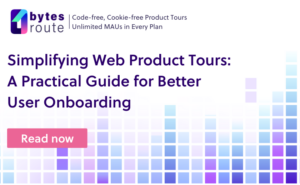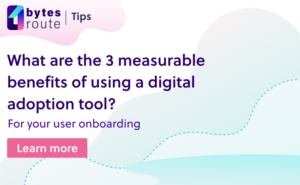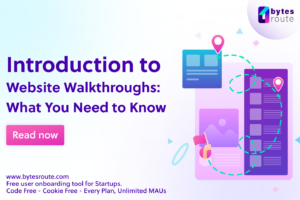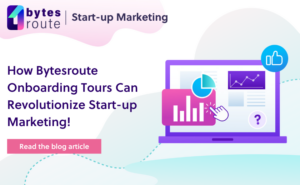We’re witnessing how people are now increasingly relying on digital solutions to deal with aspects of their personal, professional, or educational lives. As a result, customers are more educated and have more expectations when it comes to their digital experiences.
With this move towards a more digital behavior, businesses of all sizes and industries should be accelerating digital adoption to keep up with consumers and provide them with the experience they expect.
What’s a good place to start? With a digital adoption platform. In this article, we’ll go through what a digital adoption platform is and what are the benefits and challenges of integrating it into your business.
What is a Digital Adoption Platform?
A digital adoption platform is a software that provides user-oriented information about software, website applications and other products.
Its product line offers many options that make navigating easier for users, including features like step-by-step walkthroughs and interactive messages.
A digital adoption platform can collect data about user behaviors and learning materials. Using digital adoptability systems is helpful for a digitalization process if users have no prior technical knowledge when using new technology.
The Digital Adoption Platforms industry is pretty wide, but it focuses on two main use cases:
- Digital Adoption for consumers – If new users are unable to complete the customer journey and your product is not straightforward enough, you will have high churn rates and low client retention. Don’t let this happen! Use a digital adoption tool that guides users through your application to help learn to use the product and complete tasks.
- Digital Adoption for businesses – Onboarding is the core of the successful start of an employee-employer relationship. Employee onboarding is critical to ensuring that new hires are quickly integrated into the company’s culture and learn about the company’s mission and vision. New hire onboarding can set them up for future success if done right.
Employers can save time and money by implementing a digital onboarding strategy that simplifies the onboarding process and allows for a more personalized approach. A major advantage of this kind of employee training is that employees have access to the onboarding materials anytime they need them.
Interesting Digital Transformation Statistics
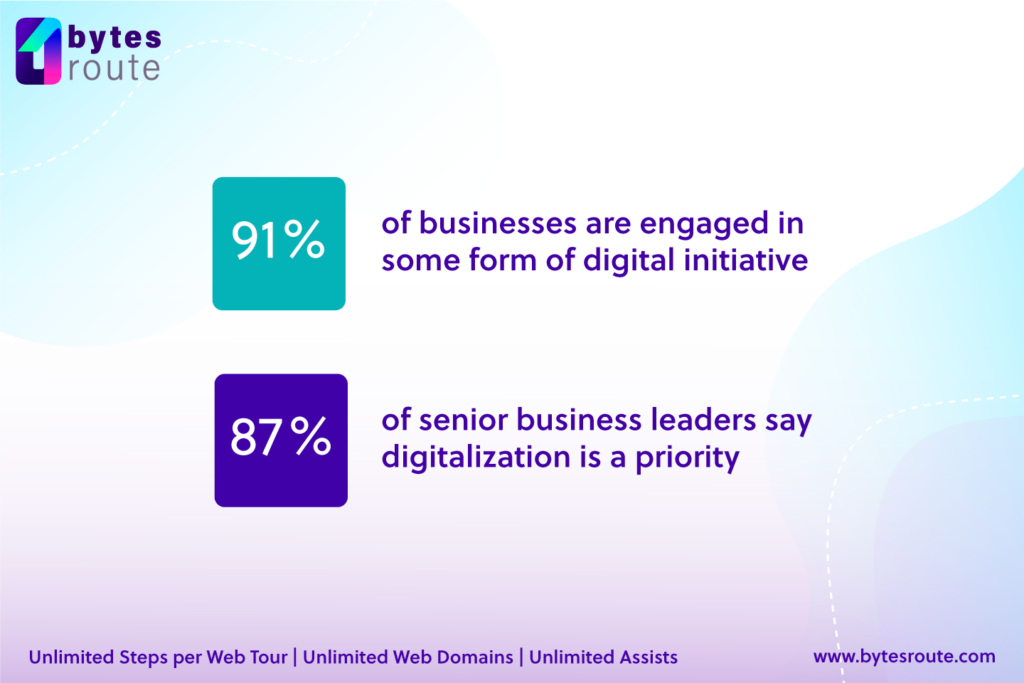
- At least 90% of new enterprise apps will insert AI technology into their processes and products by 2025. (IDC)
- Digital transformation and a focus on customer experience can generate a 20-30% increase in customer satisfaction and economic gains of 20-50%. (McKinsey)
- 70% of customers say understanding how they use products and services is very important to winning their business. (Salesforce)
- High-tech B2B companies have reported a 10% to 20% cost reduction and revenue growth of 10% to 15% from transforming their customer experience processes. (Mckinsey)
- Between 2020 and 2024, the global investment in digital transformation will almost double. (Statista)
- Key drivers of digital transformation in retail are strengthened competitiveness (70% reporting high or very high importance), improved efficiency and reduced cost (69%), strengthened customer relationships (69%) and increased revenue (67%). (Fujitsu)
- 91% of businesses are engaged in some form of digital initiative, and 87% of senior business leaders say digitalization is a priority. (Gartner)
The Challenges Faced by Organizations When it Comes to Digital Adoption
In 2022, with so many evolving technologies, digital adoption shouldn’t be optional for businesses.
While digital transformation gives organizations new opportunities to innovate and improve, it also implies some rational thinking and perhaps changing some aspects in areas of your business.
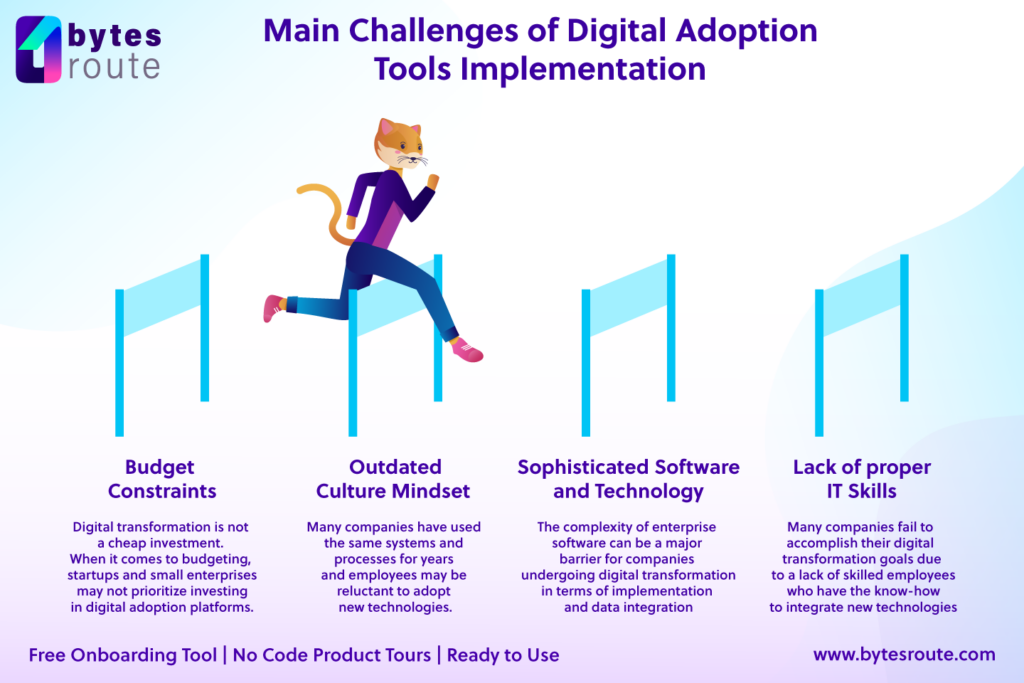
The challenges faced by organizations when it comes to digital adoption are too many to count, but the most important ones are:
- Sophisticated Software and Technology – new technologies might be a bit scary. This is a significant barrier for companies undergoing digital transformation, both from implementation and data integration viewpoint but also from the end-user experience perspective. The manager should take this into account at the beginning of the transformation process and look for a straightforward system.
- Culture Mindset – Legacy systems and manual processes are generally associated with an outdated way of doing things. Progress is slow, automation is devalued, and new technology is hard to implement. Everyone must be on the same page, from the CEO to the newest staff. As a society, we should all be prepared to undertake major life shifts and not be scared to learn new things.
- Budget Constraints – Investing in digital transformation is not cheap. For startups and small businesses, investing much money in digital adoption platforms might not be a priority when planning their budget. Understand your long-term goals and the return on investment you expect from the transformation process before you begin. This will provide you a clearer picture of how much money you have available to spend and how much room you have to grow your spending.
- Lack of IT Skills – many companies fail to accomplish their digital transformation goals due to a lack of skilled employees who have the know-how in integrating new technologies. Organizations with a shortage of IT staff can solve this problem by contracting out this work to outside consultants or digital transformation experts.
Why is Digital Adoption important?
Digital adoption is essential to any company’s success. Effective use of software is vital for improving employee productivity and ensuring company growth. This begins with an efficient onboarding process that allows new employees to get up and running fast and continues with the monitoring of areas that may be causing a blockage of support tickets.
What Are the Benefits of Integrating AI into Your Business with a Digital Solution?
A comfort zone is a wonderful place to be until you recognize you’ve outgrown what’s in front of you. Digital adoption tools are redefining the way companies operate. So, if you are considering beginning your digital transformation journey, but are still in doubt, here are some benefits of integrating digital tools to take into account:
- It helps workers concentrate on the tasks at hand.
- It reduces the need to keep track of each step involved in completing a task.
- Onboarding and training take less time.
- It increases the software adoption rate and productivity.
- It ensures that businesses stay competitive in the marketplace.
- This enables businesses to get the most out of any software they utilize.
- It improves customer engagement.
- Enhanced data collection
- Cost savings
How to Choose the Right Platform for Your Business Needs?
First and foremost, you need to think about your specific business objectives before purchasing an adoption platform.
Depending on your requirements, you should choose a tool that fits your business’s challenges.
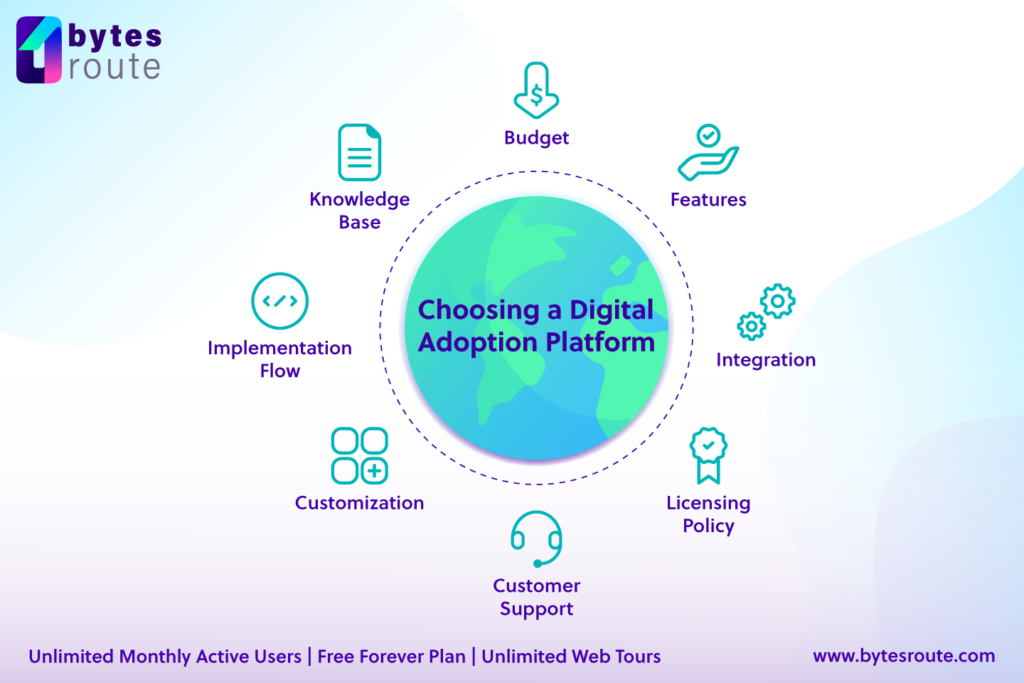
Here are some factors to consider when choosing digital adoption solutions:
- Budget – price might vary depending on the size of your organization, how many features you need and how many users you have( some platforms offer free plans).
- Features – take a look at what features are offered by the different platforms. Some tools may offer only basic features like product walkthroughs, while others have advanced features like usage data, analytics, user feedback or user segmentation. Choose the digital tool based on the complexity of your product.
- Integrations – check the specific integrations of every tool and see which ones are useful for your product.
- Licensing Policy – various product subscription plans depend on the number of MAU (Monthly Active Users), assists or product tours
- Documentation- a product’s user guide should provide all the information you’ll need to implement and use the digital adoption tool
- Customer Support – evaluate if the type of customer service offered is compatible with the needs of your business
- Implementation flow – check to see if writing code is required for the implementation. If this is the case, then knowing how much code and how many people it will take to accomplish it is necessary.
- Customization – the product tours should look like they belong on your website, they should be integrated into the design. You should be able to pick your own theme or design. For more complicated websites or web apps, code customization may be required.
- Changing Subscription Plan – your business’ needs may change over time, so you should analyze how easy it is to swap plans. Also, consider how easy it is to go from freemium to paid subscriptions and back again.
All Bytes Route’s plans come with:
- unlimited web domains to connect and use
- unlimited guided tours for a given domain
- unlimited steps defined per tour
- unlimited assists/tour sessions
- unlimited active users(MAUs) for your published tours
Our Favourite Digital Adoption Platforms
Bytes Route
Bytes Route is a code-free application designed for non-technical people to build engaging onboarding tours and tooltips for a smooth onboarding experience.
Main features
- Unlimited Web Tours – You can create as many as you need and keep them unpublished until needed live.
- Teams – You can create, edit, and manage tours together with your team.
- Analytics – See how your tours are performing and if users encounter any errors while running them.
- Tour customization – Customize the look and feel of the tours to best match your brand’s visual identity or your personal preferences.
- Multilanguage Support – Option to display the call to actions in several supported languages.
Suitable for: Start-ups, Small and Medium-sized companies
Userpilot
With Userpilot you can create personalized in-app experiences for users based on custom actions that you can set as triggers for your flows.
Main features
- Many customizable UI elements
- Analytics
- NPS & Surveys
- Event triggering & tracking
- User Segmentation
- Localization
- Flows, spotlights and checklists
Suitable for: Medium to Big-sized businesses
WalkMe
WalkMe is packed with a wide range of features, consisting of an entire suite of solutions. It’s a complex Digital Adoption Platform.
Main features
- Segmentation
- Analytics
- Multi-language Support
- Design Flexibility
- In-app training
- Surveys & Feedback
- Virtual Assistant
- Integration with many tools and platforms
Suitable for: Big-sized companies and Enterprises
Since the outbreak of the pandemic, the way businesses operate has undergone huge changes. Users’ demands and expectations have increased and traditional setups are not sufficient to satisfy them.
New digital tools and software are launching every day, so you have a wide range of options. You just need to choose the right one for your business.
Deploying an adoption platform (DAP) makes it easier to accomplish digital adoption and maximize the value of your data, systems, processes, and end users.
We hope you found this article useful and let us know what you would like us to write about.
